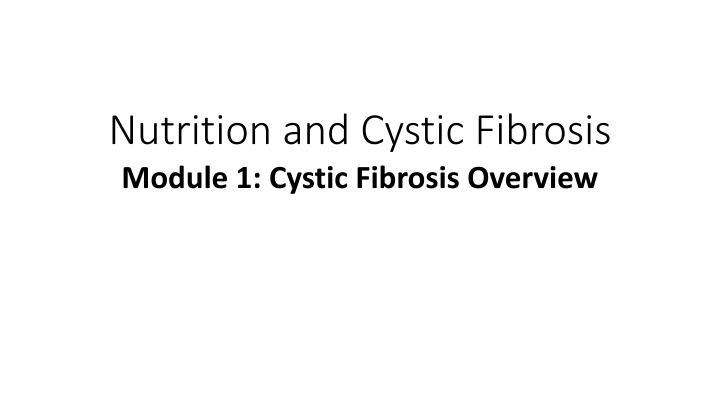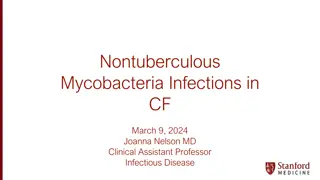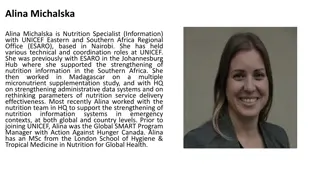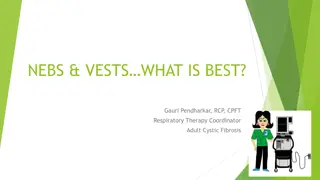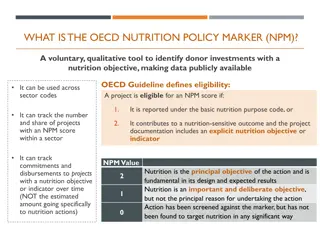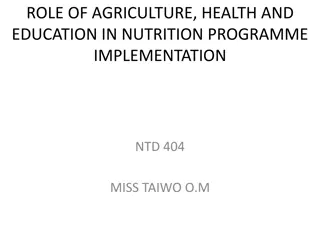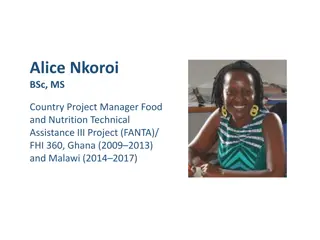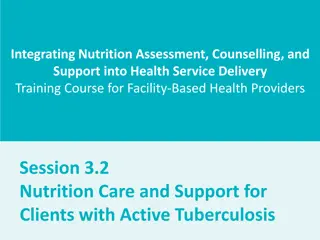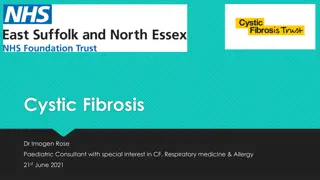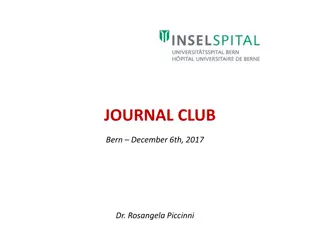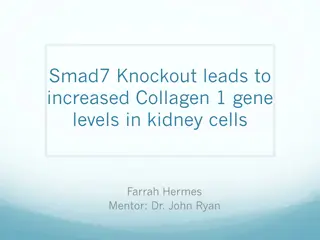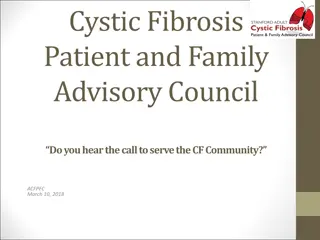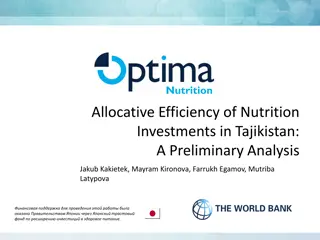Nutrition and Cystic Fibrosis
Cystic fibrosis (CF) is a genetic disorder affecting mucous production in various organs. This module explores how CF alters nutrient digestion, absorption, and metabolism, leading to malabsorption issues and nutrient deficiencies. Learn about CF diagnosis, consequences on lungs and airways, prognosis, and the interprofessional team approach in managing CF patients. Discover the role of the CFTR gene mutations in CF pathophysiology and the importance of quality health and nutrition interventions for improved outcomes.
Download Presentation

Please find below an Image/Link to download the presentation.
The content on the website is provided AS IS for your information and personal use only. It may not be sold, licensed, or shared on other websites without obtaining consent from the author.If you encounter any issues during the download, it is possible that the publisher has removed the file from their server.
You are allowed to download the files provided on this website for personal or commercial use, subject to the condition that they are used lawfully. All files are the property of their respective owners.
The content on the website is provided AS IS for your information and personal use only. It may not be sold, licensed, or shared on other websites without obtaining consent from the author.
E N D
Presentation Transcript
Nutrition and Cystic Fibrosis Module 1: Cystic Fibrosis Overview
Learning Objectives Describe the pathophysiology of cystic fibrosis, and specifically how the disease process alters nutrient digestion, absorption, and metabolism. Utilize cystic fibrosis resources including the Cystic Fibrosis Foundation (CFF) website. Discuss the interprofessional team approach in working with CF patients and their families. Describe Life Course Theory (LCT) and how this is used on the context of CF care.
What is cystic fibrosis (CF)? Genetic, autosomal recessive disorder Mutations in cystic fibrosis transmembrane regulator (CFTR) gene Changes in the CFTR protein result in production of thick mucous in epithelial tissues including in the digestive tract, respiratory tract, and sweat glands Watch the video demonstrating function of CFTR in lung cell (link under Reference Material for Module 1) There are five classes of mutations (I-V), with class I, II and III mutations resulting in more severe disease www.learn.genetics.utah.edu
www.learn.genetics.utah.edu/content/disorders/singlegene/cf/
How is CF diagnosed? Newborn screening for most common genetic mutations Results are confirmed with sweat chloride test or additional genetic testing Early detection results in improved health outcomes www.cff.org
Consequences of CF Lungs and airways Nutrition-related Malabsorption of nutrients, including fat and fat-soluble vitamins, occurs in patients with pancreatic involvement Weight loss, poor growth, and nutrient deficiencies Psychosocial issues may also impact nutrition status www.nhlbi.nih.gov/health/health-topics/topics/cf/signs
Prognosis Individuals with CF have seen significant increases in median predicted survival age Quality health and nutrition interventions are important for increased survival rates and increased quality of life https://www.cff.org/For-Caregivers/CF-Care-Centers/
CF and the GI Tract Recall that the GI tract, and specifically the small intestine is where most nutrient digestion and absorption occurs Most CF patients are pancreatic insufficient - thick mucous in the pancreas blocks the release of digestive enzymes leading to severe malabsorption in the gut Pancreatic enzyme replacement therapy (PERT) provides the necessary digestive enzymes Prescription digestive enzymes taken by mouth immediately before meals Pill burden can be high, as several pills may be required each meal and snack Adherence to PERT can vary and must be assessed at each CF clinic visit
REVIEW QUESTIONS How are macronutrients digested and absorbed? How is the pancreas involved in digestion? If an individual has fat malabsorption, what other nutrients might be affected? What are the signs and symptoms of fat malabsorption? If a pancreatic insufficient CF patient does not take prescribed digestive enzymes, what are the consequences? Would a pancreatic sufficient CF patient need to take digestive enzymes? Nutrition Therapy and Pathophysiology, Nelms et al.
CF and Nutrition Poor nutritional status is associated with worse clinical outcomes Medical nutrition therapy (MNT) is critical component of CF management High kilocalories (kcals), high fat diets are typically recommended Dietary supplements and nutrition support may be needed to reach energy requirements and support weight maintenance/gain Scandishakes, Ensure, Boost Plus, and pediatric oral supplements Enteral nutrition support indicated in failure to thrive, low weight, poor weight gain, and anorexia
CF and Nutrition CF patients regularly complete a pulmonary function test (PFT) at each CF clinic visit that measures lung function FEV1 = the amount of air that can be forcefully blown out of the lungs in 1 second FEV1 is a good measure of how much mucus is blocking the large airways Check out the CCF website information Basics of Lung Care Watch the video of an actual CF patient completing his PFTs BMI is inversely correlated with lung function as measure by FEV1 It is unclear if low BMI causes suppressed lung function or vice versa Patients and parent/caregivers should be educated on the connection to BMI and lung function
The graphs on the left show the association of BMI percentile and percent predicted FEV1 for children with CF and PI. Lower BMI is associated with lower lung function and vice versa Maintaining weight >50th percentile is recommended by the CFF (>50th percentile wt-for-length for children 2 years or less) For a 6-year-old female in the 20 percentile for BMI, what is her % predicted FEV1? Stallings, et al.
The graph on the right represents the relationship between BMI and percent predicted FEV1 for CF patients with PI aged 21-40 The same association between BMI and lung holds true for adults as with children BMI goals >22 kg/m2 for females >23 kg/m2 for males Stallings, et al.
Energy Requirement in CF REE typically increased in CF 105-130% of expected Generally hypermetabolic Individualized assessment required to determine accurate estimate of energy needs CFF guidelines call for energy needs 110-200% estimated energy requirements for age and gender Recommended kcal adjustment in increments of 10% above estimated energy requirements
Energy Needs in CF - EXAMPLE Jeremy is an 18-year-old male who was diagnosed with CF at age 3. He is pancreatic insufficient and tries to consume a high kcal, high fat diet. He generally has a low activity level. Ht: 70 in Wt: 150# BMI: 21.5 What is Jeremy s estimated energy requirement? 1. In the text, Table 2.1 provides the formula for kcals/d for Jeremy s age and gender: 88.5 (61.9 x age[yr])+ PA x (26.7 x wt[kg] + 903 x ht[m]) + 25 kcals 2. Before using the formula, convert Jeremy s height and weight into metric units. Ht: 70 in x 2.54 cm/in = 177.8 cm/1000 = 1.78 m Wt: 150 # x 1 kg/2.2# = 68.2 kg 3. Plug numbers into the formula. 88.5 (61.9 x 18)+ 1.13(26.7 x 68.2 + 903 x 1.78) + 25 kcals = 2079 kcals/d 4. Add 10% for an initial estimate of energy needs for CF. 2079 kcals/d + 10% = 2287 kcals/d* *This final estimate may need to be adjusted based on individual tolerance and weight status
Macronutrient Requirements in CF Fat provides 9 kcal/g 35-40% of total kcals Focus on monounsaturated fatty acids (MUFA) and polyunsaturated fatty acids (PUFA) vs saturated fatty acids No benefits seen with medium chain triglycerides (MCT) Protein 12-15% of total kcals OR 1.5-2 times the RDA Compare above recommendations to assess appropriate protein load Carbohydrate (CHO) - typically minimal loss of CHO in stool of CF patients Approximately 50% of total kcals calculate fat and protein first to determine Keep in mind minimum RDAs for pediatric and adult patients Moderate fiber intake as tolerated
The Interprofessional Team in CF Since cystic fibrosis (CF) is a complex disease, it requires a team approach with you or your child at the center. Your CF care team includes a group of CF health care professionals who partner with you to provide specialized, comprehensive CF care. (www.cff.org) RDNs are an integral part of the interprofessional health care team
The Interprofessional Team in CF www.cff.org
The Role of the RDN in CF Helps patients gain or maintain a healthy weight Develops a nutritional plan that is high in calories, protein, vitamins and minerals Recommends fat-soluble vitamins, pancreatic enzymes and additional dietary supplements Works with patients to meet nutritional goals, which may include tube feeding Helps patients manage CF-related diabetes (CFRD) and bone diseases like osteoporosis www.cff.org/Living-with-CF/Your-CF-Care-Team/
References Nutrition in Cystic Fibrosis, Yen and Radmer Leonard - Chapters 1-3 Cystic Fibrosis Foundation www.cff.org University of Utah Health Sciences, Genetic Science Learning Center www.learn.genetics.utah.edu National Heart, Lung and Blood Institute - www.nhlbi.nih.gov Nutrition Therapy and Pathophysiology, Nelms et al., 2nd Ed Chapter 14 Stallings et al. Evidence-based practice recommendations for nutrition- related management of children and adults with cystic fibrosis and pancreatic insufficiency: results of a systematic review. J Am Diet Assoc. 2008; 108(5):832-9.
